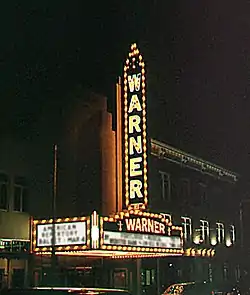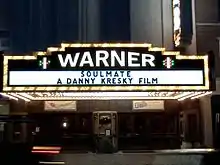Warner Theatre (Torrington, Connecticut)
The Warner Theatre is an Art-Deco style movie palace located at 68-82 Main Street in Torrington, Connecticut. It opened on August 19, 1931 as part of the Warner Bros. chain of movie theaters. Today it operates as a mixed-use performing arts center. It is individually listed on the National Register of Historic Places and also a contributing property in the Downtown Torrington Historic District.
Warner Theatre | |
 | |
  | |
| Location | 68-82 Main St., Torrington, Connecticut |
|---|---|
| Coordinates | 41°48′6″N 73°7′17″W |
| Area | 2.5 acres (1.0 ha) |
| Built | 1931 |
| Architect | Thomas W. Lamb |
| Architectural style | Art Deco, Modernistic |
| Part of | Downtown Torrington Historic District (ID88002978) |
| NRHP reference No. | 84001098[1] |
| Significant dates | |
| Added to NRHP | February 16, 1984 |
| Designated CP | December 22, 1988 |
The theater has been deemed the "finest surviving Modernistic theatre in Connecticut."[2]:11
History
The Warner Theatre was built as a first-run movie palace by Warner Bros. Studios. This elaborate art-deco building was designed by nationally renowned architect Thomas W. Lamb. The opening was a statewide event attended by then-Governor Wilbur Cross and many other dignitaries. Seating 1,772 patrons, the Warner was a stunning example of state-of-the-art technology and lush, elegant surroundings.
In the 1960s Warner Brothers sold the Warner Theatre to a private owner who continued to show movies until the late 1970s. By the early 1980s the theatre was closed and slated for demolition when a group of local citizens banded together and formed what is now known as the Northwest Connecticut Association for the Arts. This non-profit group worked passionately to save the landmark from destruction. After a successful grass-roots campaign, the association purchased the theatre and re-opened it on May 22, 1983.

The theatre is in operation year-round with more than 80,000 patrons passing through its doors each year. It provides a dynamic art-in-education program that has reached thousands of young people from throughout the region. It features a community theatre program that is supported by more than 400 volunteers—from actors to carpenters to ushers. It has presented some of the world's finest performers, from the Vienna Boys Choir to Anne Murray, and from George Carlin to the Washington Ballet. The Warner's dedicated Board of Directors represents a unique cross-section of business, education, government, and the arts, providing strong and visionary leadership for this important institution.

On October 14, 2012, independent film director Paul Rothbart[3] shot the opening scene for his short romantic comedy, "Isn't It Romantic?"[4] in the lobby of the Warner.
Restoration
Funded by an exhaustive fund-raising effort, that included generous support from the State and Federal governments, the community, and regional corporations, the Warner Theatre closed its doors in early August 2002 to complete Phase One of its restoration of the vintage Art Deco auditorium. Construction crews cleared the venue of its 1956 seating, worn wall hangings, and interim floor covering. For the next two months, the auditorium was filled with 45 ft. high scaffolding to enable the restoration of the intricately stencilled ceiling, refurbishment of the huge, silver and gold star-shaped light, and cleaning and gilding for the complex, interweaving pattern that tops the theatre's walls.
The "monkey fur"—actually crushed velvet—wall covering that was brown for more than a generation, has been restored back to its original vivid blood orange hue through a supplier in Germany. Gold brocade draperies from France now accent the walls, replace the act curtain, and dress the lobby stairway landing. The auditorium floor was also refurbished to better accommodate handicap access, and the lobby, aisle, and atrium carpeting were all restored with a recreation of the original Art Deco pattern that lined the floors when the theatre opened in 1931. The lighting, sound, and fire alarm systems were also updated, restoring the venue back to state-of-the-art status.
Damage
In 1999 a fire broke out in the theatre. A ghost light nicknamed "Larry The Light" was left too close to the act curtain by the theatre's cleaning crew. The light ignited the curtain, and the flames spread quickly. Damages amounting to $300,000 included the loss of the act curtain, damage to the stage floor, and smoke damage to the auditorium walls and ceiling.[5]
References
- "National Register Information System". National Register of Historic Places. National Park Service. March 13, 2009.
- Louisa Roraback; Wayne Devlin & John Herzan (July 30, 1983). "National Register of Historic Places Inventory-Nomination: Warner Theater". National Park Service. and Accompanying 17 photos, exterior and interior, contemporary and historic
- https://pro.imdb.com/name/nm4757466/
- https://pro.imdb.com/title/tt2768954/
- "Fire Damages Torrington Theatre". WTNH News. Retrieved 26 September 2012.